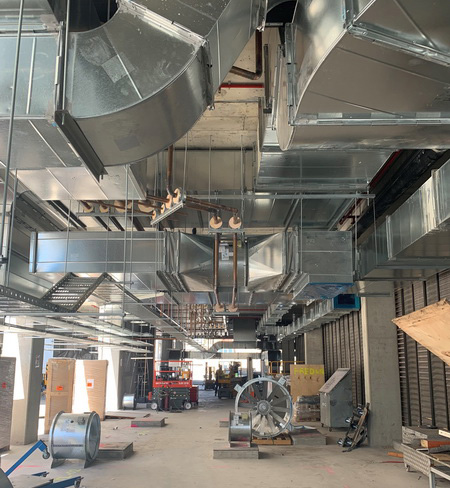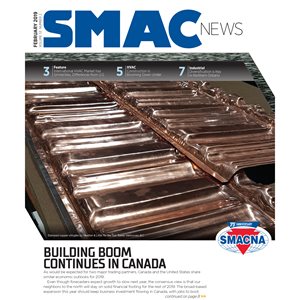Construction is Booming Down Under
One of Fredon Air's major projects includes HVAC system design, fabrication, and delivery at the central Acute Services Building at Westmead Hospital in Westmead, Sydney, New South Wales.

Fredon Air installed more than 1 million square feet of ductwork.
This year is already shaping up to be a busy year for Australia’s Fredon Air of Fairfield, Victoria. One of their major projects that includes HVAC system design, fabrication, and delivery is the central Acute Services Building at Westmead Hospital in Westmead, Sydney, New South Wales. The large 14-story, 1,333,000 square-foot building is scheduled to open in 2020.
The new building includes services that manage severe injury and illness, urgent medical conditions, recovery from surgery, and other critical and complex conditions. It contains two new emergency departments — one for adults and one for children — along with state-of-the-art operating theaters, in-patient beds, a helipad, and clinical support services.
Fredon Air was engaged by global construction company Multiplex under an early contractor involvement to design, engineer, construct, and commission this new hospital development.
“We were introduced into the project at an earlier stage than usual,” said Richard Drigo, group managing director of Fredon Air, of the contract. “This enabled us to provide a greater deal of value in engineering. We were able to optimize the design, providing significant savings as well as addressing any constructability issues, and ultimately mitigate risks for the builder and client.”
“The mechanical consultant was also engaged to provide an overview and watching brief responsible for vetting the design compiled by Fredon,” he continued. “The consultant would also model the design to check compliance with energy targets and other general project objectives.” Fredon Air has in the design phase for about 12 months and construction just started in November 2018.

Australia: The Acute Services Building. Photos Fredon Air.
Drigo considers this project a special one. “It brings together the full design and construct expertise that the business has — with the modelling that's been undertaken in-house, with the software that's been used, with the elements of off-site fabrication, and ultimately with our shop being fully responsible for the delivery of the project.”
“It's not too far different from other jobs that we've done, but it may be different than perhaps the way that other contractors do their work,” he continued. “I guess that probably sets us apart to a certain degree, given the size of the project and the time — from consulting to delivery in 18 months.”
Drigo believes that understanding their core strengths and doing the common things uncommonly well has helped Fredon create a successful formula for delivering highly complex buildings such as hospitals.
“Firstly, you need to understand the client needs and their operational requirements for the building. You then need to fully understand the overarching design guidelines for hospitals and then incorporate the prescriptive nature of compliance relative to authority regulations and standards. You bring all these factors together and then design a system that is reliable and cost effective, a system that is coordinated and buildable within the confines of the building structure, and a system that can be maintained for the lifetime of the building. Do all these things successfully and you have a successful formula.”
Fredon has completed many projects under similar circumstances during the past few years, including Northern Beaches Hospital, the Chris O'Brien Lifehouse, St. George Hospital, and Blacktown Hospital. The time frames may seem fast to some, but Drigo says, “It’s all we know. I’m not sure whether building 1,000,000 square feet of a hospital in under two years is fast comparatively to overseas. We would love to compare notes!”
Fredon Air has full design and construct responsibility for the Acute Services Building project. They are doing IES (integrated environmental solutions) modeling and thermal simulation modeling, user group meetings and interface, and heat load/static calculations/equipment selections, along with Revit BIM design and documentation. They are also handling lead coordination supervision, delivery of the building’s full mechanical air handling plant, and delivering air conditioning and ventilation to all areas of the building.
In addition, they are responsible for designing the building’s isolation/infectious diseases room, heating and chilled water plant, building management system, energy management system, steam plant serving the Central Sterile Service Department (CSSD), fume exhaust system, specialist exhaust systems, and cool rooms.
Fulfilling all those responsibilities requires quite a lot of material, including 30,000 lineal feet of chilled, hot and condenser water pipework, and more than 4,200 lineal feet of steam pipework. More than 180 air handling units and fan coil units will be installed and more than 1,000,000 square feet of total ductwork will be supplied and installed as well.
The project will create more than 1,500 new construction jobs annually and more than 50 apprenticeships. The Fredon Air workforce, including subcontractors, is expected to peak at 200 personnel on-site, with approximately 200,000 total labor hours.
A unique aspect of the project is a commitment of five percent of the total contract amount being devoted to the Aboriginal Participation in Construction (APIC) policy. The policy was developed to support greater participation by Aboriginal people in government construction projects across New South Wales. According to Drigo, the percentage is “quite significant for a metro area, so it’s going to be challenging in meeting those targets.”
Drigo is enthusiastic about business opportunities in the area over the next couple of years. “We're very optimistic. We're going through market conditions that probably haven't been seen since the Olympics were held in Sydney.”
“We've got a government that's flush with funds, and they're on a big infrastructure spend, so there's a lot of money being spent on roads and tunnels and upgrading,” he noted. “We've also got a lot of spend in the health center, hospitals, and in universities. There are many new buildings going up within the university campuses across New South Wales as well. It's going to continue for the next year or two. It's pretty positive.”
Related Links
Published: February 28, 2018
IN THIS ISSUE
Australia’s Ellis Air is Heating Up Melbourne’s Tallest Building
Melbourne’s new residential super-skyscraper, Australia 108 is the tallest residential building in the Southern Hemisphere — and SMACNA member Ellis Air helping to make it a reality.
Building Boom Continues in Canada
The economy’s prolonged strength has left Canadian sheet metal and air conditioning contractors working on major projects across the country in 2019.
Construction is Booming Down Under
One of Fredon Air's major projects includes HVAC system design, fabrication, and delivery at the central Acute Services Building at Westmead Hospital in Westmead, Sydney, New South Wales.
Diversification is Key in Northern Ontario
Diversification has ultimately been a great business strategy for Lopes Limited. The Northern Ontario, Canadian SMACNA company started out in 1976 as a small sheet metal shop operating out of a garage.
Zahner’s South Korean Tower Sparkles
A dramatic curved stainless steel façade gave the A. Zahner Co. of Kansas City, Missouri, another opportunity to further expand its geographic reach to the Harim Tower in Gangnam, Seoul, South Korea.


